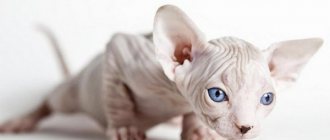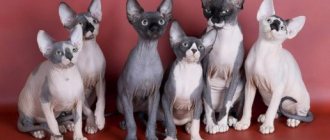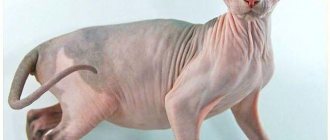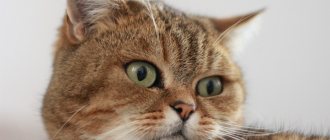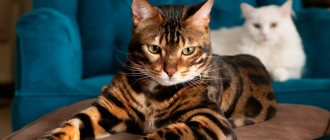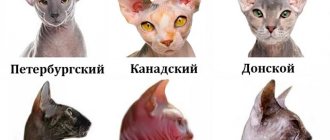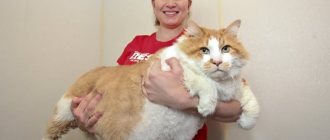Of all the Sphynxes, only the Brush variety arouses curiosity among cat lovers less than others. They traditionally prefer completely hairless animals with “rubbery” skin, and an even coat of short, plush hair immediately reduces the status of a representative of hairless cats, which in fact turns out to be quite overgrown. But there is no need to evaluate external signs so strictly - the Sphynx Brush is, in fact, a very interesting type of cat that deserves special attention from both breeders and potential owners.
Skin and coat types of sphinxes
Only 4 types of sphinxes fit the description of hairless cats. The first of these to appear were representatives of the Canadian breed, whose targeted selection began in 1960. Although the name of these sphinxes cemented their affiliation with the Country of the Maple Leaf, the main experiments were carried out in the United States.
The mutation that led to the hair loss occurred naturally for unknown reasons. The Canadian Sphynx is born with fur, and then carries residual signs of it throughout its life. He only looks completely naked from afar. In fact, the thick skin is covered with fluff (up to 2 mm), and there is short hair on the bridge of the nose. Hair growth is also allowed on the inside of the ears, between the toes, on the belly and tail. To the touch, the skin of the Canadian Sphynx gives the impression of velor or velvet pile - an almost imperceptible gentle coating.
“Canadians” are born in this form and no significant transformations occur to them throughout their lives.
Another branch is the Don Sphynx, which was bred in Russia 20 years later. The hairlessness of this breed is due to a mutation of completely different genes and, although externally similar to the Canadian Sphynx, the domestic species has significant differences:
- there are Don Sphynxes with fur;
- As cats of this breed grow older, their external signs change.
Important! It is by the condition of the skin and the presence of overgrowth that experts can distinguish between these groups of cats. Moreover, this applies to all representatives, which also include Ukrainian Levkoys and Peterbalds (St. Petersburg sphinxes).
Hulborn
Such sphinxes have had no hair since childhood. Kittens of the Canadian breed may also have this sign, but later the body becomes covered with fluff. And the Don remain naked for the rest of their lives.
Naked with whiskers and eyebrows
The second type of naked-born. They can be born with no facial hair at all, or they can have mustaches and eyebrows. This sign is typical only for this group, and in all other cases, “woolen” sphinxes demonstrate all the signs that are provided for in the breed standard.
Flock
Rare wool that fits very tightly to the body. From a distance it is not even visible, but from a close distance it becomes noticeable. The faint fluffy coating on the skin feels like a delicate red dusting, like on peach fruits. Flock cats are often called velor cats, although in fact they are two different groups.
Sphinx velor
Externally, velor Sphynx cats are very similar to flock cats, but upon closer inspection and to the touch they are completely different. The fur of velor sphinxes is longer and thicker, but it lies tightly on the body and is therefore not visible at all. Depending on the color, this visual illusion behaves differently. The black velor Sphynx seems completely naked, but if you run your finger against the fur, you can feel the obvious resistance of the hair.
Soft brush
The description of the appearance of the Sphynx Brush breed may vary depending on which animal is in mind. The coat of Sphynx cats from this group is soft and slightly wavy.
Hard brush
The second group in the description of brush sphinxes has more elastic and springy hair. It curls and looks like lamb's wool. Grows longer than the coat of a soft brush.
Straight-haired
There are also very unusual sphinxes with fur. In terms of the quality of their coat, they are very similar to shorthaired cats. This species lingered in the group of hairless cats for the only reason - experts still haven’t figured out the mechanics of genetic mutation. Overgrown Sphynx cats with fur carry a mixed “cocktail” of traits that in the next generations can give rise to full-fledged rubber, flock, velor or brush kittens.
Breeding
To breed Sphynx Brushes, the animal should be purchased from a professional, registered breeder. The most expensive are the naked ones, the sphinx velor is cheaper, while the brushes themselves are of average cost. The cost is affected by the gender and color of the animal. It may be difficult to find a partner, since in Russia this breed is not considered the most popular.
How to choose a kitten
You need to choose a kitten based on its health, knowing its pedigree. The kitten must have documents indicating its parents and grandparents. The kitten itself should be playful, active, and moderately inquisitive. There should be no discharge from the eyes and ears; this may indicate possible health problems. The animal must have all the required vaccinations and a veterinary passport with vaccination marks.
Choosing a name
It is necessary to choose a name based on the individual characteristics of a particular animal. This could be his character, origin story, interesting facts related to him.
Petersburg brush (Peterbald)
Russian breed, in the selection of which Don cats took part. Just like their predecessors, these sphinxes are covered with curly hair and some of them remain in this form for the rest of their lives. The second half “undresses” not completely. In adult cats, dense growth is observed on the face, tail and may be on the paws. This option is called brush point due to the characteristic location of the hair at the ends of the body.
Health
One of the most common health problems among Sphynx cats is obesity. Due to excess weight, cats become inactive, their joints and internal organs suffer. In this case, it is important not to overfeed the animal and accustom it to the feeding regime.
It is worth noting that Sphynx cats are the most susceptible to infections, so kittens must be vaccinated and regularly shown to a veterinarian. Mature animals get sick quite rarely, but even they have troubles: acne, skin rashes or vasculitis. Also common among Sphynxes are congenital entropion of the eyelids, damage to the spine and tail, and a short lower jaw.
But these four-legged animals can boast of a long lifespan - sphinxes live for about 13-15 years.
Features of brush sphinxes
Why sphinxes grow hair remains a mystery to breeders and geneticists. No other features are noticeable in these animals. Physically, they are completely identical to naked and flocked, but in terms of character there may be discrepancies.
Don Brushes, like all other representatives of this breed of Sphynx cats, are friendly, curious and sociable. They are easy to train and get along well with other pets.
Peterbalds are related by blood to Oriental and Siamese cats. This genetic line not only conveyed the body structure typical of people from the Asian region, but also inherited character traits. St. Petersburg brushes sometimes become aggressive or offended. But this happens extremely rarely.
No other behavioral anomalies are observed in sphinxes of all breeds. People from different continents who have undergone natural mutations are very similar in behavior, habits and ability to communicate.
Character
As it turned out, despite the common feature (lack of hair), these cats are very different in their characters. They are united by a special love of love, good nature, interest in all the affairs of the owner and, of course, high intelligence. These hairless cats are surprisingly good conversationalists, so they will find their own “meow” for any word you say.
Also be sure that the sphinx will not let you feel lonely, because he will be with you everywhere: on your lap, in the bathroom, on the kitchen counter, and if necessary, he will climb up the chandelier. They cannot stand loneliness, so under no circumstances should you avoid communicating with this tailed friend.
This breed of cats is very affectionate, so even in the most difficult moments they will support their owner and cheer him up. In addition, they are not the least bit jealous, so they easily get along with other pets and willingly share the love of their owners with them. As for relationships with children, they also benefit here, because sphinxes are always not averse to playing, which means that neither the child nor the cat will be bored.
However, there are still some peculiarities. For example, Peterbalds are not always in a good mood. Therefore, if you disturb the cat at the wrong time, then, most likely, several claws will answer you.
And Don Sphynxes can be very offended and simply ignore their owner. They are also very capricious in terms of games - you will have to constantly pamper them with new toys.
Reviews
All owners of such tailed animals are very happy with them, it is impossible not to fall in love with them; as a rule, such pets become loved by all family members, even if someone is initially put off by their appearance. Cats of this variety are disciplined, easy to train and raise, and love to be photographed.
They are loyal and love their owners, meeting them at the doorstep and following them around the house everywhere. They often sleep in bed with people, love to purr on their knees and sleep in the warmth of human hugs.
To read: Strong and intelligent hunting dog Scotch Terrier: description of the breed, character
Some take in adult animals, and they still quickly adapt to the new environment. They love children and easily find a common language with other representatives of the animal world. They do not spoil wallpaper and furniture, especially if you accustom them to scratching posts from childhood. They always go to the toilet in the litter box. The only thing that can be a problem for busy people is daily wiping, but for those who are already used to it, caring for a cat is a pleasure.
conclusions
Is it worth buying a Sphynx kitten covered with fur? It depends on the purpose of purchasing the animal. If you are planning to take your pet to exhibitions, it is better to opt for hairless cat varieties. Animals with fur may not be allowed to exhibit. However, most hairy breeds (except straight-haired) can be bred for breeding and produce hairless offspring. In addition, Sphynx cats with fur can make wonderful pets. They are distinguished by their lack of aggression, goodwill and affection.
Care
Since these purrs have non-standard hair, caring for them has some features. They have an elevated body temperature - approximately forty to forty-one degrees.
To read: Characteristics of the Dwarf Bull Terrier, reviews from owners
Therefore, they get sunburn easily. It is important not to let them spend too much time under the hot rays. The room should be warm and drafts should be avoided. When walking outside, it is important to ensure that the animal does not get wounded, because their skin is especially sensitive. It’s better not to let them out of the apartment at all.
Every day the animal needs to be wiped with water because it sweats. Once every seven days you are supposed to bathe him using a special shampoo. It is worth feeding a cat with premium food; many veterinarians do not recommend natural food. The creature has a fast metabolism, so it eats a lot. This is normal, due to this his immunity is strengthened. Cats love to try new things, like fruit. It is worth trimming your pet's claws and cleaning your pet's ears and teeth regularly. Buy him new toys, invent games, because otherwise he will be bored.
These cats live for about fifteen years, this figure is greatly influenced by nutrition. Sometimes it can change, the main factors influencing it are heredity, immunity and care.
To exclude diseases, you should regularly visit the veterinarian, get all the necessary vaccinations and give your pet vitamins. In the fall, it is important to dress him in special clothes, which are sold in pet stores. In winter, place a pad on the radiator, because the cat loves to bask there and can burn the delicate skin.
